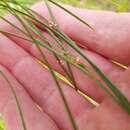Associations
provided by BioImages, the virtual fieldguide, UK
Foodplant / parasite
Coleosporium asterum parasitises live Solidago
Foodplant / parasite
aecium of Coleosporium asterum parasitises live Pinus nigra ssp. nigra
Foodplant / parasite
aecium of Coleosporium asterum parasitises live Pinus thunbergii
Foodplant / parasite
aecium of Coleosporium asterum parasitises live Pinus contorta
Foodplant / parasite
aecium of Coleosporium asterum parasitises live Pinus mugo
Foodplant / parasite
aecium of Coleosporium asterum parasitises live Pinus rigida
Foodplant / parasite
aecium of Coleosporium asterum parasitises live Pinus ponderosa
Foodplant / parasite
aecium of Coleosporium asterum parasitises live Pinus sylvestris
Foodplant / parasite
Coleosporium asterum parasitises live x Solidaster
Comprehensive Description
provided by North American Flora
Coleosporium solidaginis (Schw.) Thiim. Bull. Torrey Club
6: 216. 1878.
[/redo Solidaginis Schw. Schr. Nat. Ges. Leipzig 1 : 70. 1822.
Caeoma {Uredo) Solidaginis Schw. Trans. Am. Phil. Soc. II. 4 : 291. 1832.
Peridermium acicolum Underw. & Earle, Bull. Torrey Club 23: 400. 1896.
Stichopsora Asterum Dietel, Bot. Jahrb. 28 : 565. 1899.
Stichopsora Solidaginis Dietel, Hedwigia Beibl. 42 : 181. 1903. Pycnia amphigenous, scattered, numerous, originating between mesophyl and cortical layer, noticeable, 0.3-0.5 mm. wide by 0.5-0.8 mm. long, dehiscent by a longitudinal slit, low-conoidal, 80-i00// high.
Aecia from a limited mycelium, amphigenous, numerous, scattered on discolored spots occupying part of a leaf, erumpent from longitudinal slits, tongue-shaped, 0.5-1 mm. long by 0.5-0.7 mm. high ; peridium rupturing irregularly, moderately firm, white, cells overlapping, 35-45 fi long, not much narrower, walls transversely striate, inner coarsely verrucose, thick, 5-6//, outer less rough and somewhat thinner; aeciospores ellipsoid, 20-25 by 28-40 //; wall colorless, closely and coarsely verrucose with deciduous tubercles, which are directed away from a smooth spot extending up one side, thick, 2-3 i on the smooth spot,
increasing to 5-6/" on the opposite side, including the tubercles.
On Pinaceae :
Pinus rigida Mill., Connecticut, Massachusetts, New Jersey, New York.
Uredinia hypophyllous, rarely also epiphyllous, irregulariy scattered, or at first somewhat gregarious and crowded, 0.3-0.5 mm. across, soon naked, yellow or orangeyellow, ruptured epidermis inconspicuous; urediniospores ellipsoid or globoid, 17-22 by 20-30 /i; wall rather thin, 1-2 //, closely and strongly verrucose ; contents orange-yellow when fresh, fading to colorless,
- bibliographic citation
- Joseph Charles Arthur. 1907. UREDINALES; COLEOSPORIACEAE, UREDINACEAE, AECIDIACEAE (pars). North American flora. vol 7(2). New York Botanical Garden, New York, NY
Coleosporium asterum: Brief Summary
provided by wikipedia EN
Coleosporium asterum is a species of rust fungus in the family Coleosporiaceae. It infects species in the Asteraceae family, such as those in genus Aster and Solidago, as well as the needle pines Pinus contorta and P. banksiana. It has been recorded on aster family species Canadanthus modestus, Eurybia conspicua, Solidago missouriensis, Symphyotrichum ciliolatum, S. laeve, and numerous others.
The basionym of Coleosporium asterum is Stichopsora asterum, and the fungus originally was found in 1898 on leaves of the Asteraceae species Callistephus chinensis, Aster scaber (now Doellingeria scabra), and Aster tataricus on the island of Honshu, Japan.
- license
- cc-by-sa-3.0
- copyright
- Wikipedia authors and editors

